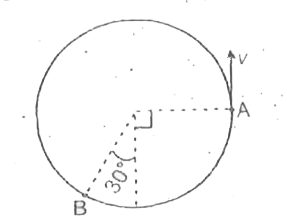A particle of mass m moving with a speed v hits elastically another stationary particle of same mass m on a smooth horizontal circular tube of radius r, as shown in figure. The time in which in the next collision will take place is equal to

4πrv
2πrv
3πr2v
πrv
The correct Answer is:B

There is no force in the horizontal direction.
∴ The horizontal momentum will remain constant.
∴v.sinϕ=usinθ ….(1)
By definition e=Vertical velocity after collisionVertical velocity before collision
E=vcosϕucosθ
∴vcosϕ=eucosθ ....(2)
Squaring and adding (1) and ( 2), we get
v2(sin2ϕ+cos2ϕ)=u2sin2θ+e2u2cos2θ
∴v2=u2(sin2θ+e2cos2θ)
∴v=u√sin2θ+e2cos2θ
Topper's Solved these Questions
Similar Questions
A particle of mass m moving with a speed v hits elastically another staionary particle of mass 2m on a smooth horizontal circular tube of radius r. Find the time when the next collision will take place?
View SolutionA particle of mass m moving with a speed v hits elastically another staionary particle of mass 2m on a smooth horizontal circular tube of radius r. Find the time when the next collision will take place?
View Solution
Knowledge Check
- Question 1 - Select One or More
A particle (A) of mass m1 elastically collides with another stationary particle (B) of mass m2. Then :
Am1m2=12 and the particles fly a part in the opposite direction with equal velocities.Bm1m2=13 and the particles fly apart in the opposite direction with equal velocities.Cm1m2=21 and the collision angle between the particles is 60∘ symmetrically.Dm1m2=21 and the particles fly apart symmetrically at an angle 90∘ - Question 2 - Select One
A particle of mass m moving with speed V collides eleastically with another particle of mass 2mFind speed of smaller mass after head on collision
Av3B−v3C2v3D−2v3
A particle of mass m moving with a speed v hits elastically another staionary particle of mass 2m on a smooth horizontal circular tube of radius r. Find the time when the next collision will take place?
View SolutionA particle of mass m moving with a speed v hits elastically another staionary particle of mass 2m on a smooth horizontal circular tube of radius r. Find the time when the next collision will take place?
View SolutionA particle of mass m moving with speed V collides elastically with another particle of mass 2m. Find speed of smaller mass after head on collision
View SolutionA particle of mass 2m moving with velocity v strikes a stationary particle of mass 3m and sticks to it. The speed of the system will be
View SolutionA particle of mass m moves with constant speed v on a circular path of radius r as shown in figure. The average force on it during its motion from A to B is
 View Solution
View SolutionA particle of mass m moves with constant speed v on a circular path of radius r as shown in figure. The average force on it during its motion from A to B is
 View Solution
View Solution

